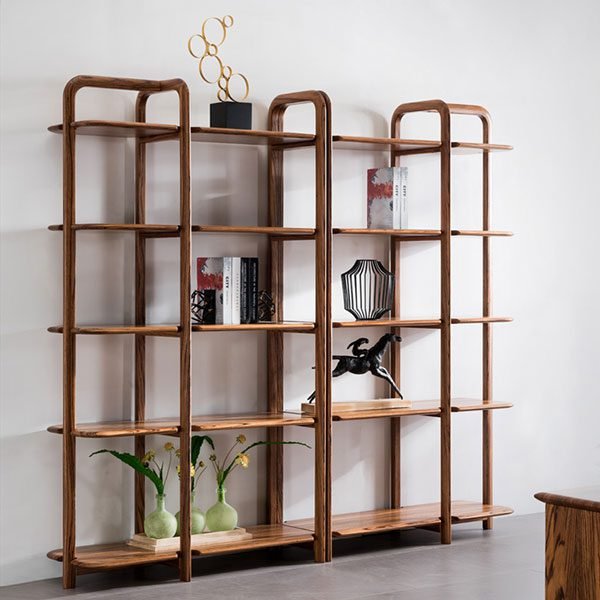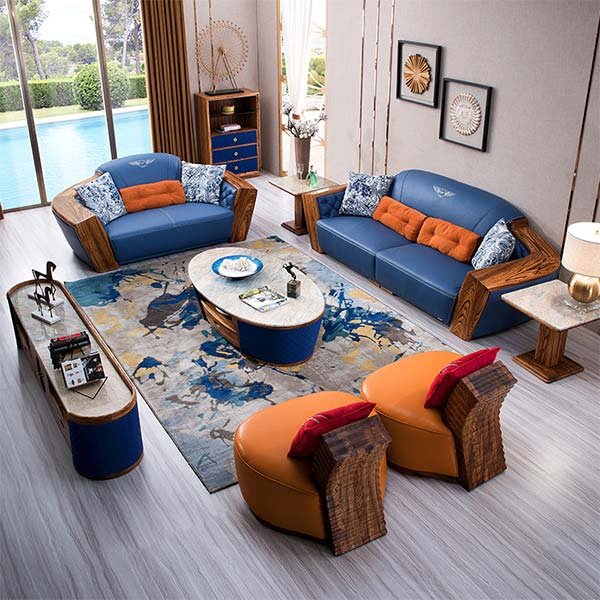“Embrace the Timeless Elegance: Wooden Furniture for Modern Architecture.”
The Influence of Wooden Furniture on Modern Architectural Design
Wooden furniture has been a staple in interior design for centuries, and its timeless appeal continues to influence modern architectural design. The use of wooden furniture in contemporary spaces not only adds warmth and character but also creates a connection to nature. This article will delve into the influence of wooden furniture on modern architectural design, exploring its versatility, sustainability, and ability to create a harmonious living environment.
One of the key reasons why wooden furniture has such a significant impact on modern architectural design is its versatility. Wood can be crafted into various shapes and forms, allowing designers to create unique and innovative pieces that complement the overall aesthetic of a space. From sleek and minimalist designs to intricate and ornate details, wooden furniture can adapt to any style or theme.
Moreover, wooden furniture brings a sense of warmth and coziness to modern spaces. In an era dominated by technology and artificial materials, the natural beauty of wood provides a refreshing contrast. The texture and grain of wood create a tactile experience that cannot be replicated by synthetic materials. This tactile quality adds depth and richness to a space, making it more inviting and comfortable.
In addition to its aesthetic appeal, wooden furniture also offers numerous environmental benefits. As a renewable resource, wood is a sustainable choice for furniture production. Unlike plastic or metal, wood can be harvested responsibly and replenished over time. By choosing wooden furniture, architects and designers contribute to the preservation of forests and reduce their carbon footprint.
Furthermore, wooden furniture has a long lifespan, making it a durable investment. With proper care and maintenance, wooden pieces can last for generations, unlike their mass-produced counterparts made from cheaper materials. This longevity not only reduces waste but also adds value to the overall design of a space. Wooden furniture tells a story of craftsmanship and quality, creating a sense of heritage and timelessness.
Another significant influence of wooden furniture on modern architectural design is its ability to create a harmonious living environment. Wood has a natural ability to absorb and release moisture, regulating humidity levels in a space. This feature contributes to a healthier indoor environment, reducing the risk of mold and mildew growth. Additionally, wood has acoustic properties that help to absorb sound, creating a more peaceful and serene atmosphere.
In conclusion, wooden furniture plays a crucial role in modern architectural design. Its versatility, sustainability, and ability to create a harmonious living environment make it a timeless choice for interior spaces. Whether it is a sleek and minimalist design or an ornate and intricate piece, wooden furniture adds warmth, character, and a connection to nature. By incorporating wooden furniture into their designs, architects and designers create spaces that are not only aesthetically pleasing but also sustainable and inviting.
Exploring the Timeless Appeal of Wooden Furniture in Contemporary Spaces
Insight into the Timeless Nature of Wooden Furniture in Modern Architecture
Wooden furniture has been a staple in interior design for centuries, and its timeless appeal continues to captivate homeowners and designers alike. In contemporary spaces, wooden furniture adds warmth, character, and a touch of nature that is hard to replicate with other materials. This article explores the enduring charm of wooden furniture in modern architecture, highlighting its versatility, durability, and ability to create a harmonious balance between tradition and innovation.
One of the key reasons why wooden furniture remains popular in modern architecture is its versatility. Wood can be crafted into various shapes and forms, allowing designers to create unique and customized pieces that fit seamlessly into any space. From sleek and minimalist designs to intricate and ornate details, wooden furniture can adapt to different styles and aesthetics, making it a versatile choice for both residential and commercial projects.
In addition to its versatility, wooden furniture is also known for its durability. When properly cared for, wooden pieces can last for generations, making them a sustainable and long-lasting investment. Unlike other materials that may deteriorate over time, wooden furniture can withstand the test of time, retaining its beauty and functionality for years to come. This durability is particularly important in modern architecture, where longevity and sustainability are highly valued.
Furthermore, wooden furniture has the unique ability to create a harmonious balance between tradition and innovation. In contemporary spaces, where modern materials and technologies often dominate, wooden furniture adds a sense of warmth and authenticity. It brings a connection to nature and a sense of history that can be lacking in purely modern designs. By incorporating wooden furniture into modern architecture, designers can create spaces that feel both timeless and current, appealing to a wide range of tastes and preferences.
Moreover, wooden furniture has a natural beauty that is hard to replicate with synthetic materials. The grain patterns, textures, and colors of different wood species add depth and visual interest to any space. Whether it’s the rich tones of mahogany, the light hues of oak, or the rustic charm of reclaimed wood, each type of wood has its own unique character that can enhance the overall aesthetic of a room. This natural beauty is particularly valued in modern architecture, where the use of organic materials is often favored.
In conclusion, wooden furniture continues to hold a special place in modern architecture due to its timeless appeal. Its versatility, durability, and ability to create a harmonious balance between tradition and innovation make it a popular choice among homeowners and designers. The natural beauty of wood adds warmth and character to contemporary spaces, creating a connection to nature and a sense of history. Whether it’s a sleek and minimalist design or an intricately detailed piece, wooden furniture has the power to transform any space into a timeless and inviting environment.
The Sustainable and Eco-Friendly Aspects of Wooden Furniture in Modern Architecture
Wooden furniture has been a staple in interior design for centuries, and its timeless appeal continues to captivate homeowners and architects alike. In modern architecture, wooden furniture not only adds warmth and character to a space but also offers numerous sustainable and eco-friendly benefits. This article delves into the sustainable aspects of wooden furniture in modern architecture, shedding light on its enduring popularity.
One of the key reasons why wooden furniture is considered sustainable is its renewable nature. Unlike materials such as plastic or metal, wood is a natural resource that can be replenished through responsible forestry practices. By choosing wooden furniture, architects and homeowners contribute to the preservation of forests and the reduction of deforestation.
Furthermore, wooden furniture has a significantly lower carbon footprint compared to furniture made from other materials. The production of wood requires less energy and emits fewer greenhouse gases, making it a more environmentally friendly choice. Additionally, wood has the ability to store carbon dioxide, helping to mitigate climate change.
In addition to its sustainable qualities, wooden furniture also offers a range of health benefits. Unlike synthetic materials, wood does not release harmful chemicals into the air, improving indoor air quality. This is particularly important in modern architecture, where energy-efficient buildings can sometimes trap pollutants indoors. Wooden furniture also has a natural ability to regulate humidity levels, creating a comfortable and healthy living environment.
Another advantage of wooden furniture is its durability. When properly cared for, wooden pieces can last for generations, reducing the need for frequent replacements. This not only saves money but also reduces waste and the consumption of resources. In a world where fast furniture has become the norm, investing in high-quality wooden furniture is a sustainable choice that promotes longevity and reduces waste.
Moreover, wooden furniture can be easily repaired and refurbished, further extending its lifespan. Scratches and dents can be sanded out, and the furniture can be refinished to restore its original beauty. This not only saves money but also reduces the demand for new furniture production.
In terms of aesthetics, wooden furniture adds a touch of warmth and natural beauty to modern architecture. Its organic textures and grains create a sense of harmony and connection with nature, enhancing the overall design of a space. Whether it’s a sleek and minimalist interior or a rustic and cozy setting, wooden furniture effortlessly complements various architectural styles.
In conclusion, wooden furniture continues to be a timeless choice in modern architecture due to its sustainable and eco-friendly aspects. Its renewable nature, low carbon footprint, and ability to improve indoor air quality make it an environmentally conscious choice. Additionally, its durability and ability to be repaired and refurbished contribute to reducing waste and promoting longevity. From an aesthetic standpoint, wooden furniture adds a touch of warmth and natural beauty to any space. As architects and homeowners strive for sustainable and eco-friendly design solutions, wooden furniture remains a steadfast and reliable option.
Заключение
Заключение: Исследование показывает, что деревянная мебель сохраняет свою актуальность и востребованность в современной архитектуре. Ее временная природа, естественная красота и уникальные текстуры делают ее привлекательным выбором для дизайнеров и архитекторов. Дерево вносит теплоту и органичность в современные пространства, создавая гармоничное сочетание с современными материалами и технологиями. Благодаря своей прочности и долговечности, деревянная мебель может служить не только функциональным элементом, но и художественным выражением в современной архитектуре.



